 MELTING CHOCOLATE is defined as using indirect heat to convert chocolate from a solid to a liquid, such as done when melting or tempering chocolate.
MELTING CHOCOLATE is defined as using indirect heat to convert chocolate from a solid to a liquid, such as done when melting or tempering chocolate.
WHEN TO MELT OR TEMPER?
This techniques is used with the Dark Chocolate Plastic Recipe
Chocolate is sensitive to both heat and moisture:
Chocolate melts best at temperatures between 104 and 113 degrees F (40 and 45 degrees C). The process starts around the low 90 degrees F when the cocoa butter in it starts to heat. Melting temperatures must never exceed 115 degrees F (milk and white) and 120 degrees F for dark, otherwise it will seize or burn or clump and thicken or become grainy. To measure, use a Chocolate or Candy Thermometer. Remove the chocolate from the heat and stir gently before measuring. Insert the tip of the thermometer in the bowl, and hold it there. Take care not to let it rest on the bottom or touch the sides of the bowl.
Make sure no beads of moisture are allowed to mingle with the chocolate while melting or it will likely seize. If this happens, you can fix it. (Once fixed it can no longer be used for tempering.)
HOW TO TIPS:
Chocolate melts best when it is first chopped into 1/4-inch evenly sized pieces. When melting chocolate chips, candy melts or chocolate that comes in small wafers, there is no need to chop it.
SARAH SAYS: When melting one or two 1- or 2- ounce squares at a time, there's no need to chop it.
With a sharp knife, placing one hand on the handle and the other on top of the knife, press straight down on the chocolate to chop it.
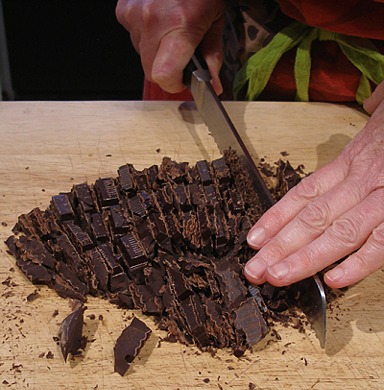
Different chocolate melting techniques: Never place chocolate directly in a pan over heat or microwave it, unless using small amounts for a recipe. Because of the sensitivity of milk solids to heat, chocolate is best melted in a double boiler, or in the oven. White and milk chocolate will burn more easily than bittersweet or dark chocolate. Chocolate chips and candy melts(compound chocolate) will also burn.
1. Double Boiler Method:
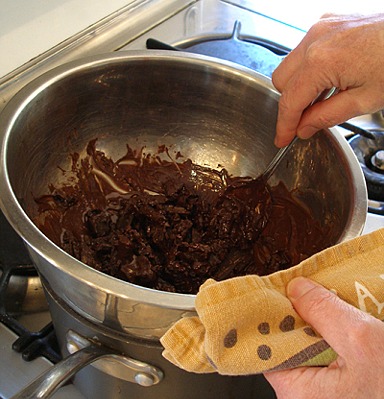
Melting chocolate in a double boiler applies to all chocolate in both small and large amounts. It is a two part pan, with one stacked on the other. You can also make your own by setting a heat-proof glass bowl over the pan. The size of the bowl holding the chocolate will dictate the size of the pan below. Make sure the bowl isn't too deep so the chocolate will melt more evenly. Use a pot whose lip comes halfway up the side of the glass bowl, so the bowl can remain suspended. Make sure the bowl completely covers the top of the pot so no moisture or steam can escape. The bottom of the bowl must NOT touch any water placed in the pot below because the chocolate will get too hot, causing it to seize or burn. Because chocolate is moisture adverse, you want condensation, steam and splashes to be minimized to prevent it from seizing and ruining the batch.
To do:
A. Fill the saucepan on the bottom with a few inches of water or just enough to create heat and steam. Bring the water to a rolling bowl, uncovered. Turn off the heat and remove. If the water is too hot (really steaming), let it cool a bit or the chocolate will seize, become grainy or burn when placed on top.
B. Wipe off the top if the pot. Place the chopped chocolate in the top pan of double boiler, and then place it on the pot with the hot water. Let the chocolate sit and melt from the indirect heat from the steam. Stir the chocolate occasionally until it ALMOST melts (it will still retain some of its shape and look shiny).
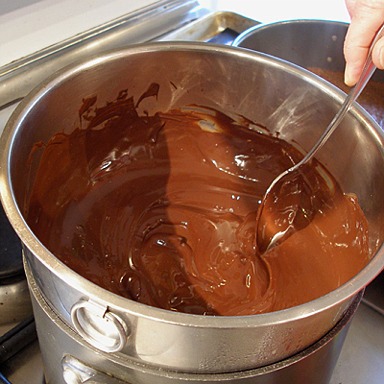
If the water cools too much, remove the top pot and reheat before proceeding.
C. Remove the top of the double boiler, and stir the chocolate very well until fully melted. The chocolate will be about 115 to 120 degrees F when measured with a Chocolate Thermometer. If some pieces of chocolate remain unmelted, repeat heating it over the double boiler for a few seconds at a time, taking care not to burn it. Stir gently.
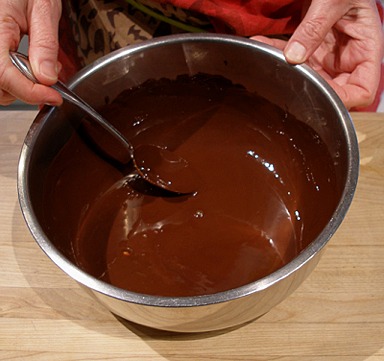
D. Let the chocolate sit for about 10 minutes to cool slightly, and give it a good stir before using.
2. Oven Method:
SARAH SAYS: The no water technique for melting chocolate in an oven, inspired by my mom.
Place chopped chocolate in a heat-proof bowl and place it in an oven set at 110 degrees F (if your oven doesn't go that low, use the lowest temperature and keep the door ajar). Your chocolate will melt very slowly.
Another way is to melt a few chocolate squares while your oven preheats, but watch it very carefully. Place in a heat-proof bowl or in a piece of aluminum foil with formed raised sides (so the chocolate won’t run off the foil) on the middle shelf. It will take 5 to 15 minutes for it to melt, depending on the amounts. Remove when almost melted and stir until all of it is.
3. Microwave Method: Best for small amounts, only. Because milk and white chocolate contain milk proteins, they can overheat quickly and become grainy. They need to be removed from the microwave and stirred sooner than dark chocolate.
To do:
- Place one ounce of more of evenly chopped chocolate or chocolate chips in a microwave-safe bowl.
- Microwave on medium (50 percent) checking every 10 – 15 seconds. Chocolate holds its form and looks shiny (it won't look melted), so stir several times to check.
- Let chocolate stand for thirty seconds with the microwave turned off.
- Remove the container and stir the chocolate until completely melted.
Adding melted chocolate to baking recipes:
If using melted chocolate in a recipe, you need to temper it, not to be confused with tempering chocolate. Tempering chocolate in recipes is a technique used to prevent chocolate from seizing or hardening beyond repair, when combining with cooler ingredients or batter.
How to melt chocolate with other ingredients: The rule of thumb is, the minimum is 1 tablespoon water-type liquid for every 2 ounces of chocolate.
You can melt chocolate and other liquids together, such as water, but there are some rules. You can't melt a large amount of chocolate with a small amount of butter or cream – you need to have the right proportions to prevent the chocolate from seizing. Shortening is 100% fat and does not contain water, so you don't need to be concerned about the chocolate to water ratio when you use shortening!
Examples:
4 tablespoons of butter = 1 tablespoon of water (butter is about 18% water)
4 tablespoons liqueur = 1 tablespoon water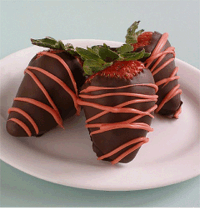
5 large egg yolks = 3 tablespoons water
4 tablespoons cream = 3 tablespoons water
How to melt chocolate with shortening:
Always melt the chocolate first, and then add in the shortening. The applies to real chocolate, chocolate chips and candy melts.
This technique is used with the Classic Chocolate Covered Strawberries Recipe.
HOW TO:
1. Stir the shortening into the just melted chocolate.
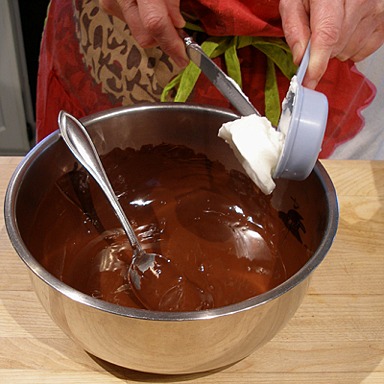
2. Stir until completely melted and smooth.

3. Let the mixture cool to tepid (100 degrees F – body temperature) for dipping.
How to melt chocolate with paraffin wax:
NOTE: PARAFFIN IS HIGHLY FLAMMABLE. Never leave the melting wax unattended or use high heat.
WARNING: Melt the chocolate and the wax separately, but do NOT try to melt the chocolate and wax together (unless using chocolate chips).
Some recipes call for adding paraffin wax so the chocolate hardens with a sheen. It is perfect when working with small amounts of chocolate, such as dipping cookies or fruit. However, paraffin is not necessary for successful dipping and you may not like its flavor. If you are using top-quality chocolate, it already has everything in it that you need. Paraffin is found in the grocery store.
- Melt the chocolate. Remove from heat.
- Melt the wax in an uncovered pot over very low heat. It doesn't take that long, so watch carefully. Remove from heat.
- When both the chocolate and the wax are still molten, but cooled slightly, pour the wax into the chocolate slowly, stirring constantly. Stand back while doing so or don't look into the pot directly; you don't want either to splash and hit you — both are VERY HOT.
How to melt chocolate chips with paraffin:
Can melt together in the top of a double boiler over hot water: I use 1/4 bar (1-ounce) paraffin wax per 1 (12-ounce) package of semisweet chocolate chips. I use this also when making Christmas candies. To dip Spritz cookies, hold a cooled cookie at an angle – from corner to opposite corner – and dip into the melted chocolate/wax mixture. Set aside on a wax paper covered cookie sheet. When all dipping is completed put the dipped cookies in the refrigerator for about 30 minutes to quickly harden the chocolate.


